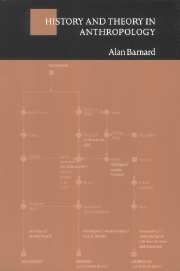Book contents
- Frontmatter
- Contents
- List of figures
- List of tables
- Preface
- 1 Visions of anthropology
- 2 Precursors of the anthropological tradition
- 3 Changing perspectives on evolution
- 4 Diffusionist and culture-area theories
- 5 Functionalism and structural-functionalism
- 6 Action-centred, processual, and Marxist perspectives
- 7 From relativism to cognitive science
- 8 Structuralism, from linguistics to anthropology
- 9 Poststructuralists, feminists, and (other) mavericks
- 10 Interpretive and postmodernist approaches
- 11 Conclusions
- Appendix 1 Dates of birth and death of individuals mentioned in the text
- Appendix 2 Glossary
- References
- Index
8 - Structuralism, from linguistics to anthropology
- Frontmatter
- Contents
- List of figures
- List of tables
- Preface
- 1 Visions of anthropology
- 2 Precursors of the anthropological tradition
- 3 Changing perspectives on evolution
- 4 Diffusionist and culture-area theories
- 5 Functionalism and structural-functionalism
- 6 Action-centred, processual, and Marxist perspectives
- 7 From relativism to cognitive science
- 8 Structuralism, from linguistics to anthropology
- 9 Poststructuralists, feminists, and (other) mavericks
- 10 Interpretive and postmodernist approaches
- 11 Conclusions
- Appendix 1 Dates of birth and death of individuals mentioned in the text
- Appendix 2 Glossary
- References
- Index
Summary
‘Structuralism’ refers to those theoretical perspectives which give primacy to pattern over substance. For a structuralist, meaning comes through knowing how things fit together, not from understanding things in isolation.
There are some similarities between structuralism and structural-functionalism: both are concerned with relations between things. However, there are important differences. Structural-functionalism finds order within social relations. Structuralists are generally as interested in structures of thought as in structures of society. Moreover, the structural-functionalism of Radcliffe-Brown was based mainly on inductive reasoning. One starts with data and sees what generalizations can be made about them. Structuralists often employ a method which is primarily deductive, that is, based on certain premises. Structuralists might follow these premises and see where they lead, rather as in algebra or geometry. They often prefer to work out logical possibilities first, and then see how ‘reality’ fits. Indeed, for a true structuralist, there is no reality except the relation between things.
Claude Lévi-Strauss has been interested in both the internal logic of a culture and the relation of that logic to structures beyond the culture – the structure of all possible structures of some particular kind. This is especially the case in his work on kinship (e.g., Lévi-Strauss 1969a [1949]; 1966a), arguably the most structured realm of culture. Yet, while Lévi-Strauss is both the best known and the most characteristic of structuralist thinkers, structuralist thought is applicable more widely.
- Type
- Chapter
- Information
- History and Theory in Anthropology , pp. 120 - 138Publisher: Cambridge University PressPrint publication year: 2000
- 3
- Cited by



